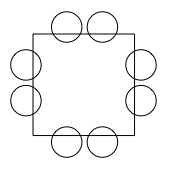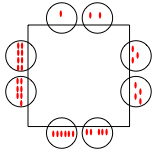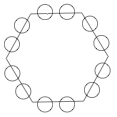Copyright © University of Cambridge. All rights reserved.
'Sitting Round the Party Tables' printed from https://nrich.maths.org/
Show menu
Why do this problem?
This activity gives pupils the opportunity to explore some simple number relationships, from which they can be encouraged to make some generalisations. It may also be a good context in which to help pupils ask their own questions - "I wonder what would happen if we ...?" showing their curiosity. You will be aware that a lot of perseverance
is helpful in solving this challenge. The "Teacher Support" at the bottom of this page is recommended in regard to the curiosity aspect of this task.
Possible approach
With younger pupils or those with little experience of exploration in mathematics and talking about their mathematical thoughts, it would be good to act out the problem as first described.
With more experienced pupils you could just present the challenge orally and ask them to explore further. Encourage learners to write down all the things they notice. It might also be appropriate for you to bring everyone together after some time to discuss how they are recording their work.
Invite pupils to ask and begin to answer their own questions: "I wonder what would happen if I ...?". You could use some of the suggestions in the problem itself to prompt those who may not be used to doing this.
Key questions
Tell me about what you have noticed about the numbers of sweets.
What else are you going to explore?
Tell me about what's going on at the other party tables.
Are there any special things you notice about the seats in particular places?
Possible extension
Some pupils might look at generalisations that they can say about tables of ANY size or of ANY shape.
Possible support
Some pupils may find it helpful to approach the problem using practical equipment, for example using counters to represent the sweets and having 'tables' made out of paper or card.
Teacher Support
This task was created to help in the pursuance of curiosity within the Mathematics lessons.
Help may be found in the realm of curiosity in watching parts of these excellent videos.
Firstly "The Rise & Fall of Curiosity", particularly the extract [23.50 - 37.15] on "adult encouragement answering and teacher behaviour."
Secondly, "The Hungry Mind: The Origins of Curiosity", particularly the extract [8.22 - 12.29] on "Children asking questions.
First can also be found at - https://www.youtube.com/watch?v=X-0NOrIU67w
Second can also be found at https://www.youtube.com/watch?v=Wh4WAdw-oq8



